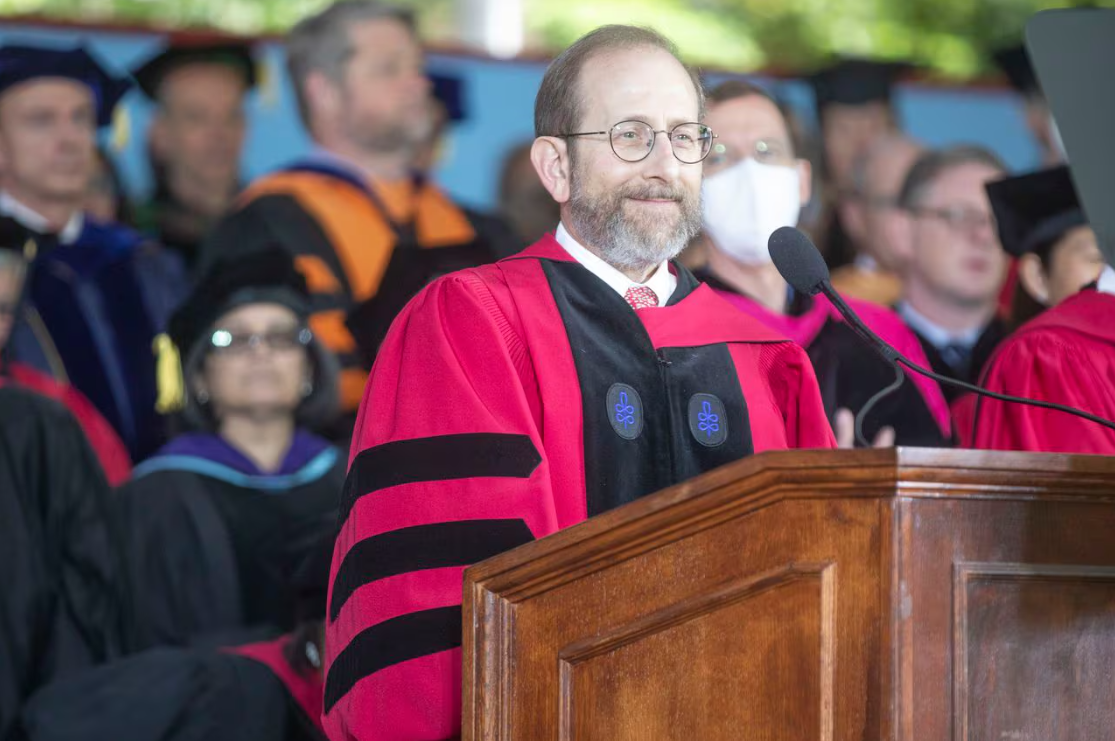临时校长艾伦·加伯如何和平结束哈佛抗议营地 这是否提高了他保住大学最高职位前景?

【中美创新时报2024 年 5 月 15 日编译讯】(记者温友平编译)说任何人都赢得了哈佛庭院之战并不完全正确。但该大学的临时校长艾伦·M·加伯(Alan M. Garber)暂时幸免于难。《波士顿环球报》记者希拉里·伯恩斯(Hilary Burns)对此作了下述详细报道。
经过大约三周的露营后,抗议者于周二离开院子,他们可能很快就会恢复学生身份。学校领导已同意开会讨论大学的投资实践,但加伯告诉他们哈佛不会从以色列撤资。毕业典礼的准备工作可以继续进行,这可以让成千上万的机票和酒店预订者松一口气。
加伯比抗议者坚持得更久,而且没有报警,也没有使用过分的言辞来羞辱学生示威者。这是哈佛大学近代历史上最严峻的学术年之一的最好情况,当然也是加伯职业生涯中的最好情况。一些人认为,这次对他领导力的考验证明了他永久担任校长的勇气。
“我怀疑这强化了艾伦处理冲突的方式,”哈佛医学院教授、放射科医生、加伯的老朋友芭芭拉·麦克尼尔说。她形容他是一个公正、冷静、逻辑性强的人,具有“思考下游后果的能力”。
神秘的哈佛公司,即该校的最高管理委员会,尚未组建一个搜寻委员会来寻找克劳丁·盖伊的继任者。克劳丁·盖伊因抄袭指控和对校园反犹太主义处理方式的批评而于 1 月 2 日辞职。一些教师认为这是对加伯迄今为止表现的认可。
加伯拒绝接受采访,没有表示他是否对这个永久职位感兴趣。
在过去的几周里,加伯面临着来自学生、教授、校友、家长和保守派政客的巨大压力,他们对如何处理抗议者及其撤资要求持有强烈且相互矛盾的观点。
抗议者的斗争有时会变得激烈对抗、针对个人且恶毒。抗议者在加伯位于霍桑街的家外高喊口号。上周,哈佛庭院的一棵树上挂着一张海报,将犹太人加伯描绘成一个长着角和尾巴的魔鬼,坐在马桶上,上面写着:“艾伦·垃圾资助种族灭绝。”将犹太人描述为恶魔是一个长期存在的反犹太主义比喻。
“数百人游行到你家,站在你家前的草坪上对你尖叫,辱骂你,压力令人难以置信,”哈佛医学院前院长、哈佛教职人员关于学术自由委员会联合领导者杰弗里·弗利尔 (Jeffrey Flier) 说。 “你看起来像魔鬼的照片——我不希望我最大的敌人看到这些。”
抗议者说,事情还没有真正结束。示威者表示,他们正在进入“一个新阶段的开始”…… 在他们争取哈佛从以色列撤资的斗争中,“战略发生了转变”。“哈佛要小心了,”哈佛大学“走出被占领巴勒斯坦”组织在拆除营地前在其 Instagram 账户上发帖称,“解放区无处不在。”
加伯是一位参加过马拉松比赛的跑步运动员,以深思熟虑、头脑清醒而闻名。作为一名拥有经济学博士学位的医生,他一生都在思考医疗干预的价值,权衡治疗的有效性和成本。
他此前曾担任哈佛大学教务长约十几年。几位教员形容他有原则、公正。历史学教授艾莉森·弗兰克·约翰逊表示,即使是那些有时不同意他的决定的人也尊重他。
“他并不介意你不同意他的观点,”弗兰克·约翰逊谈到加伯担任教务长的时期时说道。“他有着无限的求知欲。如果你对他为何做出错误选择有异议,他想听听。”
加伯拥有三个哈佛大学学位,于 1976 年完成了经济学本科学位,随后获得了经济学硕士和博士学位,并发表了一篇关于抗生素耐药性成本的论文。在哈佛大学攻读博士学位的同时,加伯还在斯坦福大学医学院攻读医学学位。
他在波士顿布莱根妇女医院完成了住院医师计划,之后加入斯坦福大学任教,在那里他教授医学、健康研究和政策以及经济学 25 年。2011年,他在哈佛大学前校长德鲁·福斯特 (Drew Faust) 的带领下回到剑桥。
盖伊一月初离职后,他被任命为临时校长。自上任以来,他帮助缓解了校园的紧张局势,10 月 7 日哈马斯领导的对以色列的袭击后,校园因抗议和争议而陷入混乱。
哈佛法学教授理查德·拉扎勒斯 (Richard Lazarus) 表示:“至少可以说,今年一月,他走上了哈佛历史上最具挑战性的时期之一。” “他立即创造了一些急需的平静。”
加伯成立了两个工作组来研究和打击反犹太主义以及反穆斯林和反阿拉伯偏见。当哈佛大学前校长拉里·萨默斯和反诽谤联盟首席执行官乔纳森·格林布拉特批评加伯任命犹太复国主义著名学者德里克·彭斯拉尔共同领导反犹太主义委员会时,加伯并没有动摇。麦克尼尔说,加伯会仔细考虑决策,这可能是他接受过经济学训练的结果。
麦克尼尔说:“艾伦比许多其他学校的降温效果更好。” “这只是他作为一个人的反映。”
加伯在春季学期的大部分时间里重建了捐助者、家庭和未来学生之间的信任,他们担心秋季学期的争议,其中一些人对学校失去了信心,并对校园里反犹太主义的报道深感担忧。一位发言人说,他走遍全国和国际,亲自会见校友和捐助者,并与剑桥的相关附属机构举行了会议。他还成立了一个工作组,探讨采取中立政策,即大学不会对时事采取任何立场,以保护学生和教师的学术自由。
“我是临时校长,”加伯二月份对哈佛杂志说。“但我们需要解决的问题不是暂时的问题。”
整个冬天,他更新了校园抗议指南,基本上禁止在校舍内举行示威活动,并限制对大学运作的干扰。一些人批评他,指出过去几代学生使用建筑收购和其他破坏性策略来推动变革。2001年,学生们占领了校长办公室所在的马萨诸塞州大厅,并建立了一个营地,以争取哈佛工人的生活工资。根据学生报纸《哈佛深红报》的一篇评论文章,这些努力基本上取得了成功,抗议者几乎没有受到任何纪律处分。
参加 2001 年抗议活动的两名哈佛大学肯尼迪学院毕业生最近在《深红报》上写道,相比之下,加伯对加沙抗议者的反应“让人感到轻蔑”。
然而,与秋季相比,春季学期进展相对顺利,直到四月下旬,哥伦比亚大学示威者被捕后,学生们在哈佛庭院露营。
学生组织者试图引起人们对加沙不断上升的死亡人数的关注,自从以色列在哈马斯领导的恐怖袭击后入侵加沙以来,已有超过 34,000 人死亡。他们希望哈佛披露并撤资以色列的投资,并撤销对支持巴勒斯坦的学生的纪律指控。
尽管一些校友和捐助者呼吁执法部门以武力将其拆除,但哈佛领导人仍让这个营地矗立了数周。加伯也没有与抗议者谈判;包括布朗大学和罗格斯大学在内的一些学校因满足亲巴勒斯坦的要求而迅速遭到保守派政客和捐助者的强烈反对。
相反,加伯威胁要对学生进行纪律处分,最终让他们停学,这样他们就不能再自由进出哈佛校园和周围的建筑。他最终给了亲巴勒斯坦学生抗议者一些保全面子的让步,但没有做出撤资的承诺;更重要的是,他同意一切,但放弃了停职。有些人仍面临单独的纪律处分程序。
但最终,他只是让学生们呆在一个锁着的、基本上废弃的哈佛校园里,让他们感觉不舒服、效率低下,且无法使用浴室、食物或外面的世界,从而比他们活得更久。抗议者周一晚上投票决定拆除营地。
本月晚些时候将从哈佛大学肯尼迪学院毕业的莱安德罗·乌尔巴诺(Leandro Urbano)表示,这场冲突似乎已经得到解决,而学校在秋季没有经历持续的媒体风暴。
“加伯校长在与双方打交道时更加平衡,”乌尔巴诺说。他补充说,参加营地的学生也保持“文明”。
哈佛大学生物人类学家丹尼尔·利伯曼(Daniel Lieberman)曾与加伯一起跑步,他说,加伯最近几天可能依赖于他的马拉松训练。
利伯曼说,长跑运动员“不要放弃”。“这与耐力有关。”
《波士顿环球报》记者 Maddie Khaw 对本报道作出了贡献。
题图:哈佛大学临时校长艾伦·加伯在第 371 届毕业典礼上发表讲话。KRIS SNIBBE/哈佛大学
附原英文报道:
How Alan Garber ended the Harvard protest encampment peacefully
Has this test of his mettle elevated his prospects for keeping the university’s top job?
By Hilary Burns Globe Staff,Updated May 14, 2024
It would not be quite right to say that anyone won the battle of Harvard Yard. But Alan M. Garber, the interim president of the university, has survived it — for now.
Protesters were exiting the yard Tuesday after about three weeks of camping out, and they’ll likely be reinstated soon as students. School leaders have agreed to meet to discuss the university’s investment practices, but Garber has told them Harvard will not divest from Israel. Preparations for commencement can move forward, to the relief of thousands with plane tickets and hotel reservations.
Garber outlasted the protesters, and did so without calling in police or using over-the-top rhetoric to shame student demonstrators. It’s a best-case scenario in one of the grimmest academic years in Harvard’s recent history — and, surely, in Garber’s career. Some think this test of his leadership has proven his mettle to stay on permanently as president.
“I suspect it reinforces Alan’s approach to conflict,” said Barbara McNeil, a Harvard Medical School professor, radiologist, and longtime friend of Garber. She described him as even-handed, calm, logical, with the “ability to think about downstream consequences.”
The secretive Harvard Corporation, the school’s top governing board, has yet to assemble a search committee to find a successor to Claudine Gay, who resigned on Jan. 2 amid plagiarism accusations and criticism of her handling of campus antisemitism. Some faculty view this as a nod to Garber’s performance thus far.
Garber, who declined an interview, has not indicated whether he is interested in the permanent role.
In the last several weeks, Garber faced enormous pressure from students, professors, alumni, parents, and conservative politicians with strong and conflicting views on what should be done about the protesters and their divestment demands.
The protesters’ fight has sometimes turned harshly confrontational, personal, and vicious. Protesters have chanted outside Garber’s Hawthorn Street home. Last week a poster hung from a tree in Harvard Yard portrayed Garber, who is Jewish, as a devil, with horns and a tail, sitting on a toilet, with the words: “Alan Garbage funds genocide.” The depiction of Jews as demons is a longstanding antisemitic trope.
“It’s unbelievably stressful to have hundreds of people march to your house and stand on your front lawn screaming at you, calling you names,” said Jeffrey Flier, a former dean of Harvard Medical School who co-leads a Harvard faculty group, the Council on Academic Freedom. “Pictures of you looking like the devil — these are things that I wouldn’t wish on my worst enemy.”
And it isn’t really over, protesters say. The demonstrators said they are entering “the beginning of a new phase . . . a shift in strategy” in their fight to get Harvard to divest from Israel. “Harvard beware,” the Harvard Out of Occupied Palestine group posted on its Instagram account just before dismantling the camp, “the Liberated Zone is everywhere.”
A runner who has raced in marathons, Garber is known as thoughtful, cerebral. A physician with a PhD in economics, he has spent a lifetime thinking about the value of medical interventions, weighing the effectiveness of a cure against its costs.
He previously served as Harvard’s provost for about a dozen years. Several faculty members described him as principled and fair. Even those who at times have disagreed with his decisions respect him, said Alison Frank Johnson, a history professor.
“He didn’t mind that you disagreed with him,” Frank Johnson said about Garber’s time as provost. “He was boundlessly intellectually curious. If you have an argument about why he is making the wrong choice, he wants to hear it.”
Garber holds three Harvard degrees, completing his undergraduate degree in economics in 1976, before earning a master’s and PhD in economics, publishing a dissertation on the costs of antibiotic resistance. While pursuing his doctorate at Harvard, Garber was also working toward a medical degree at the Stanford University School of Medicine.
He completed a residency program in Boston at Brigham and Women’s Hospital before joining the faculty at Stanford, where he taught medicine, health research and policy, and economics for 25 years. He returned to Cambridge in 2011 under former Harvard president Drew Faust.
He was appointed interim president when Gay departed in early January. Since stepping into the role, he has helped defuse tension on a campus that was roiled by protests and controversies after the Oct. 7 Hamas-led attack on Israel.
“He stepped in to the leadership position this past January at, to say the least, one of the most challenging times in Harvard’s history,” said Richard Lazarus, a Harvard Law professor. “He created some much-needed immediate calm.”
Garber created two task forces to study and combat antisemitism and anti-Muslim and anti-Arab bias. When former Harvard president Larry Summers and Jonathan Greenblatt, chief executive of the Anti-Defamation League, criticized Garber’s appointment of Derek Penslar, a leading scholar of Zionism, to co-lead the committee on antisemitism, Garber did not waver. Garber thinks through decisions carefully, likely a result of his economics training, McNeil said.
“Alan has kept the temperature down more than at many other schools,” McNeil said. “It’s just a reflection of who he is as a person.”
Garber spent much of the spring semester rebuilding trust among donors, families, and prospective students who were concerned about the controversies from the fall, some of whom had lost faith in the institution and were deeply worried about reports of antisemitism on the campus. He traveled around the country and internationally to meet with alumni and donors in person, a spokesperson said, and held meetings with concerned affiliates in Cambridge. He also formed a working group to explore adoption of a policy of neutrality, in which the university would not take any position on current affairs to protect academic freedom of students and faculty.
“I am the interim president,” Garber said to Harvard Magazine in February. “But the problems we need to deal with are not interim problems.”
Over the winter he updated campus guidelines on protests to essentially forbid demonstrations in school buildings and limit disruption to university operations. Some criticized him, noting past generations of students used building takeovers and other disruptive tactics to push for changes. In 2001, students occupied Massachusetts Hall, home to the president’s office, and set up an encampment to push for living wages for Harvard workers. The efforts were largely successful and protesters received little or no discipline, according to an op/ed in the Harvard Crimson, the student newspaper.
Two Harvard Kennedy School graduates who participated in the 2001 protest recently wrote in the Crimson that Garber’s response to the Gaza protesters, in contrast, “feels contemptuous.”
Yet, the spring semester was going relatively smoothly compared to the fall, until late April when students camped out in Harvard Yard after demonstrators at Columbia University were arrested.
Student organizers sought to bring attention to the growing death toll in Gaza, where more than 34,000 have died since Israel invaded after the Hamas-led terror attack. They wanted Harvard to disclose and divest Israeli investments, and to drop disciplinary charges against students related to pro-Palestinian advocacy.
Harvard leaders let the encampment stand for weeks despite calls from some alumni and donors to call on law enforcement to remove it with force. Garber also didn’t negotiate with protesters; some schools that did, including Brown University and Rutgers University, faced swift backlash from conservative politicians and donors for engaging with pro-Palestinian demands.
Instead, Garber threatened to discipline the students, eventually suspending them so they could no longer move freely in and out of Harvard Yard and the surrounding buildings. He ultimately gave the pro-Palestinian student protesters a couple of face-saving concessions but made no commitments about divestment; more substantially, he agreed to all but drop the suspensions. Some still face separate disciplinary proceedings.
Ultimately, though, he simply outlasted them by making it uncomfortable and unproductive for the students to stay in a locked, largely abandoned Harvard Yard, without access to bathrooms, food, or the world outside. The protesters voted Monday night to dismantle the camp.
Leandro Urbano, who will graduate from the Harvard Kennedy School later this month, said the conflict seemed to come to a resolution without the constant media firestorm the school endured in the fall.
“President Garber has been much more balanced in his dealing with both sides,” Urbano said. He added that students participating in the encampment also remained “civilized.”
Garber has likely relied on his marathon trainings in recent days, said Daniel Lieberman, a biological anthropologist at Harvard who used to run with Garber.
Long-distance runners “don’t give up,” Lieberman said. “It’s about endurance.”
Globe correspondent Maddie Khaw contributed to this report.

